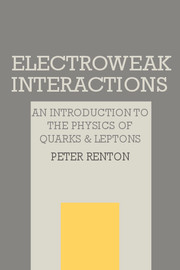Book contents
- Frontmatter
- Contents
- Preface
- 1 Introduction
- 2 Towards a quantum field theory
- 3 Wave equations, propagators and fields
- 4 Quantum electrodynamics
- 5 From Fermi theory to the standard model
- 6 Purely leptonic interactions
- 7 Deep inelastic scattering and quantum chromodynamics
- 8 Weak hadronic currents, electroweak interference effects
- 9 Quark and lepton oscillations
- 10 The standard model and beyond
- Appendix A Units
- Appendix B Properties of γ-matrices
- Appendix C Cross-sections, decay rates and Feynman rules
- Appendix D Dirac δ-function
- Appendix E Fierz transformation
- Appendix F Creation and annihilation operators for a Dirac field
- References
- Index
10 - The standard model and beyond
Published online by Cambridge University Press: 05 August 2012
- Frontmatter
- Contents
- Preface
- 1 Introduction
- 2 Towards a quantum field theory
- 3 Wave equations, propagators and fields
- 4 Quantum electrodynamics
- 5 From Fermi theory to the standard model
- 6 Purely leptonic interactions
- 7 Deep inelastic scattering and quantum chromodynamics
- 8 Weak hadronic currents, electroweak interference effects
- 9 Quark and lepton oscillations
- 10 The standard model and beyond
- Appendix A Units
- Appendix B Properties of γ-matrices
- Appendix C Cross-sections, decay rates and Feynman rules
- Appendix D Dirac δ-function
- Appendix E Fierz transformation
- Appendix F Creation and annihilation operators for a Dirac field
- References
- Index
Summary
In this chapter the production and properties of the massive gauge bosons W± and Z0 are discussed. The properties of the other gauge boson, the massless photon, were described in Chapters 4, 5 and 7. The properties of time-like virtual W± particles were discussed in Chapters 6 and 8, in the context of the decays of leptons and hadrons. Both the photon and the W± can be used as probes of the elementary constituents of hadrons. Here, for space-like four momenta such that Q2 ≳ 5 GeV2, the gauge bosons behave essentially as point-like probes. For much lower values of Q2, the W±, Z0 and the photon (in particular, the real photon) have hadronic components, arising from their fluctuations to qq pairs. Because of the difficulty in measuring the variables xBJ and Q2 in deep inelastic scattering in the case of neutral current interactions, these reactions have mainly been used to study the couplings of the Z0 to quarks (Section 8.8), rather than to study QCD effects. Interference phenomena between γ and Z0 exchange have been observed for space-like momenta in charged lepton deep inelastic scattering (Section 8.9.1), and for time-like momenta in e+ e- annihilation (Section 6.3 and 8.9.2).
Experimentally, the most important missing ingredient of the standard model is the Higgs scalar, which is needed to give masses to the particles. The complete list of quarks and leptons must also be established.
- Type
- Chapter
- Information
- Electroweak InteractionsAn Introduction to the Physics of Quarks and Leptons, pp. 487 - 564Publisher: Cambridge University PressPrint publication year: 1990



